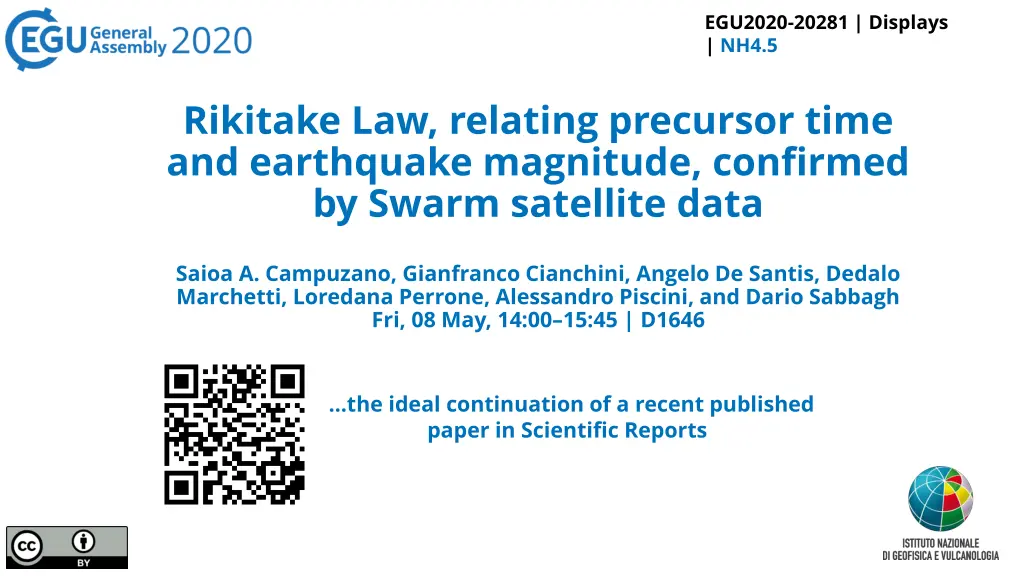
Swarm Satellite Data Confirms Rikitake Law in Earthquake Analysis
Explore the confirmation of the Rikitake Law, linking precursor time and earthquake magnitude, through Swarm satellite data analysis. Discover how different bands of earthquake magnitude align with specific satellite magnetic anomalies satisfying the law, and delve into the relationship between magnetic anomalies and earthquake characteristics such as duration and rms/RMS. Insights on corrections for longitude differences and magnetic latitude effects are also discussed.
Uploaded on | 2 Views
Download Presentation

Please find below an Image/Link to download the presentation.
The content on the website is provided AS IS for your information and personal use only. It may not be sold, licensed, or shared on other websites without obtaining consent from the author. If you encounter any issues during the download, it is possible that the publisher has removed the file from their server.
You are allowed to download the files provided on this website for personal or commercial use, subject to the condition that they are used lawfully. All files are the property of their respective owners.
The content on the website is provided AS IS for your information and personal use only. It may not be sold, licensed, or shared on other websites without obtaining consent from the author.
E N D
Presentation Transcript
EGU2020-20281 | Displays | NH4.5 Rikitake Law, relating precursor time and earthquake magnitude, confirmed by Swarm satellite data Saioa A. Campuzano, Gianfranco Cianchini, Angelo De Santis, Dedalo Marchetti, Loredana Perrone, Alessandro Piscini, and Dario Sabbagh Fri, 08 May, 14:00 15:45 | D1646 the ideal continuation of a recent published paper in Scientific Reports
Rikitake law (1987) T: precursor time M: earthquake magnitude Log T(days)=a+bM log( T)=-2 ( 1)+0.8 ( 0.2)M Anomalies of Swarm satellite magnetic field detected analysing the first differences during quiet magnetic periods (|Dst| 20 nT and ap 10 nT) when the rms of the considered window is larger than 2.5-3 times the RMS of the whole satellite track De Santis et al., Scientific Reports, 2019 2
What type of satellite magnetic anomaly is satisfying the Rikitake law? Some examples for different bands of magnitude. Band M5.5-5.9 Band M6.0-6.4 2017-01-04 01:06:10 17.869 S 167.124 E M5.6 Depth 22.1 km 2014-09-04 05:33:50 21.387 S 173.323 W M6.0 Depth 35.0 km In orange we provide information of the corresponding earthquake 3
What type of satellite magnetic anomaly is satisfying the Rikitake law? Some examples for different bands of magnitude. Band M6.5-6.9 Band M7+ 2015-01-07 05:07:07 5.904 N 82.658 W M6.5 Depth 8.0 km 2016-05-18 16:46:43 0.495 N 79.616 W M6.9* Depth 29.9 km In orange we provide information of the corresponding earthquake *This event is a part of a cluster whose equivalent magnitude is 7.1 and the cluster epicenter is 0.47 N 79 68 W 4
Then For each magnetic anomaly in the selected maximum concentration we extract the following information: - Period of the anomaly (in seconds) - Duration of the anomaly (in seconds) - rms/RMS and look at their possible relationship with the corresponding associated EQ. In general, we found that the period (about 10 sec.) is almost independent of the earthquake magnitude, while Duration and rms/RMS depend significantly on the earthquake magnitude. 5
Duration Correction by EQ longitude Duration has no evident correlation with magnitude. When corrected by the longitude difference w.r.t. EQ epicentre the correlation improves and become significant (p =0.05). 6
rms/RMS Correction by magnetic latitude rms/RMS has a weak correlation with magnitude. When corrected by the magnetic latitude the correlation improves and it is more significant. Weak Dependence with magnetic latitude 7
Future possibilities (Sciencefiction or reality?) In principle, once an anomaly is detected over a seismogenic region we could predict magnitude from duration and rms/RMS (Mdur and Mrms). If both estimated values almost agree (Mdur ~ Mrms), applying the Rikitake law, we could also predict the estimated time of EQ occurrence, completing the prediction. Duration Magnitude (Mdurand Mrms) Rikitake law Anomaly detection If Mdur~ Mrms T: EQ occurrence (Period) rms/RMS Limitations: Satellite must pass over the seismogenic area at the right time. Prediction can be made only at low latitudes (high latitudes are affected by auroral and polar magnetic activity). Several anomalies should be detected in the same area before the prediction might be accurate. Many magnetic anomalies occur for other reasons, i.e. not followed by a seismic event. This point can be partially addressed integrating the study with other satellite and ground data! 8






















